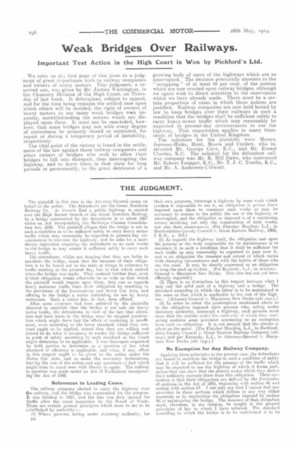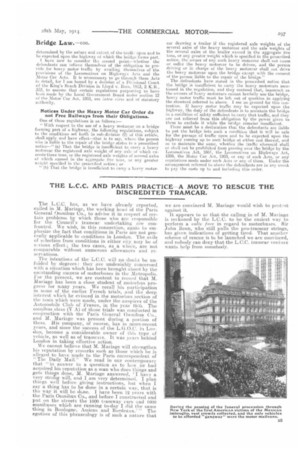THE JUDGMENT.
Page 2

Page 3

If you've noticed an error in this article please click here to report it so we can fix it.
The plaintiff in this case is the Atturney-Gelieral suing on behalf of the public. The defendants are the Great Northern Railway Cu. At Crouch End a public highway is carried over the High Barnet branch of the Great .Northern Railway by a bridge constructed by the defendants in or about 1867 under an Act incorporating the Railways Clauses Consolidation Act, 1845. The plaintiff alleges that the bridge is not in such a condition as to be sufficient safely to carry heavy motor traffic which may reasonably he expected in present-day circumstances to traverse the highway, and he asks for a mandatory injunction requiring the defendants to do such works to the bridge as may render it sufficient safely to carry such heavy traffic.
The defendants, whilst not denying that they are liable to maintain the bridge, insist that the measure of their obligation is to be found not in the state of things in reference to traffic existing at the present day, but in that which existed when the bridge was made. They contend further that, even if their obligation would otherwise be as wide as that which the plaintiff would impose upon them, they can as regards heavy motorcar traffic limit their obligation by resorting to the provisions of the Locomotives and Motor Car Acts, and affixing to the bridge a riot-ice forbidding its use by heavy motorcars. Such a notice has, in fact, been affixed.
After some evidence had been adduced by the plaintiffs directed to establish that the bridge is not safe for heavy muter traffic, the defendants, in view of the fact that alteration had been made in the bridge since itsoriginal construction which might have had the effect of rendering it insufficient, even according to the lower standard which they contend ought to be applied, stated that. they are willing and intend to do what is necessary to render the bridge sufficient in point of safety according to such standard as the Court might determine to be applicable. I was thereupon requested by both parties to determine as a questiou of law what standard of efficiency is applicable, and what., if any, effect in this respect ought ta he given to the notice under the Motor Car Acts, and to make the necessary declarations, leaving the rest of the action and any questions el fact which might arise to stand over with liberty to apply. The railway in question was made under an Act of Parliament. incorporating the Act of 11145.
References to Leading Cases.
The railway company elected to carry the highway over the railway, and the bridge was constructed for the purpose. It was finished in 1867, and the line was duly opened for traffic after the usual inspection by the Board of Trade. There are cortaiu general principles which seem to me to be tatahlished by authority :— (1) Where persons, acting under statntory authority, for 134
their own purposes, interrupt a highway by some work which renders it impossible to use it, an obligation is prima fuels imposed upon them to construct such works as may be necessary to restore to the public the use of the highway so interrupted, and the obligation so imposed is of a continuing nature involving not only the construction of such works, but also their maintenance. (Per Fletcher Moulton, L.J. in Hertfordshire County Council v. Great Eastern Railway, 1609, 2 K.I3.' p. 412.)
(2) As regards the highway itself, the obligation cast upon the persons or the body responsible for its maintenance is to maintain it in such a condition that it shall be sufficient for such traffic a,s may reasonably be expected to pass over it, and is an obligation the measure and extent of which varies with changing circumstance and with the habits of those who use the road. It, may be shortly expressed as an obligation to keep the road up-to-date. (Per Kennedy, L.J., in Attorney General v. Sharpness New Docks. This case has not yet been efficially reported.) (3) There is no distinction in this respect betwaen what I may call the solid part of a highway and a bridge. The standard according to which the latter is to be maintained is the same as that which is applicable to the rest of the highway. I Attorney-General v. Sharpness New Docks (ubi sup.)•.1
(4) In order to rebut the presumption mentioned above as to the obligation imposed upon persons who, acting under statutory authority, interrupt a highway, such persons must show that the statute under the antharity of which they were acting contains some provision amounting to an exemption from such nu obligation. It is not enough that the statute ia silent on the point. 1Per Fletcher Moulton, L.J., in Hertfordshire County Council v. Great Eastern Railway Company (ubi sup.) and per Kennedy, L.J., in Attorney-General v. Sharpness New blocks (ubi
No Exemption for Any Railway Company.
Applying these principles to the present case, the defendants ore bound maintain the bridge in such a condition of safety that it will be sufficient for the passage of the traffic which may be expected to use the highway of which it forms part, unlesa they can show that the statute under which they derive their authority exempts them from this obligation. Their contention is that. their obligations are defined be the foscicuiu.i. of sections in the Act of 1845, beginning wits section 46 and ending with section 67. I can only say that I cannot find any provision in those sections which dAnes in any way either oxpressly or by implication the obligation imposed by section 46 of maintaining the bridge. The measure of that obligation must, therefore, in my opinion, be sought in the general principles of law to which I have referred. The standard according to which the bridae is to be maititained is to be
determined by the nature and extent of the traffic upon and to be expected upon the highway el which the bridge forms part.
I have now to consider thu second point—whether the defendants can relieve themselves of the obligation to provide for heavy motor traffic by availing themselves of the provisions of the Locomotives on Highways Acts and the Motor Car Acta. It is unnecessary to go through these Acts in detail, for I am bound by a decision of a Divisional Court of the King's Bench Division in Lloyd v. Ross. 1913, 2 K.B., 332, to assume that certain regulations purposing to have brim made by the Local Government Board under seefion 12 the Motor Car Act, 1903, are ;Ora rires and of statutory
!hority.
Notices Under the Heavy Motor Car Order do not Free Railways from their Obligations.
One of these regulations is as follows:—
" With respect to the use of a heavy motorcar on a bridge forming part of a highway, the following regulations, subject to the conditions set forth in sub-division (2) of this article, shall apply and have effect—that is to say, where the person who is liable to the repair of the bridge states in a prescribed notice—" (a) That the bridge is insufficient to carry a heavy motorcar the registered axle weight of any axle of which exceeds three thns, or the registered axle weights of several axles of which exceed in the aggregate five tons, -or any greater \wieldspecified in the prescribed notice; or " (b) That the bridge is insufficient to carry a -heavy motor ear drawing a trailer if the registered axle weights of the several axles of the heavy motorcar and the axle weights of the several axles of the trailer exceed in the aggregate live tons, or ao.y greater weight which is specified in the prescribed not ie0. the owner of any such heavy motorcar shall not cause or suffer the heavy motorcar to be driven, and the person driving or in charge of the heavy motorcar shall not drive the heavy motorcar upon the bridge except with the consent of the person liable to the repair of the bridge."
The defendants have stated in the prescribed notice that the bridge is insufficient, to carry the heavy motorcars MCIItioned in the regulation, and they contend that-, inasmuch as the owners of heavy motorcars cannot lawfully use the bridge, heavy motor traffic must be left out of question in applying the standard referred to above. I see no ground for this contention. If heavy motor traffic may be expected upon tho highway, the duty of the defendants is to maintain the bridge in a condition of safety sufficient to carry that traffic, and they are not relieved from this obligation by the power given to them to exclude it while the bridge remains insufficient.
'Clore most be a declaration that the defendants are liable to put the bridge into such a condition that it will be safe for the passage of traffic upon and to be expected upon the highway coming up to such bridge at either end thereof, and so to maintain the same, whether the traffic aforesaid shall or shall not he prohibited from passing over the bridge by the Locomotives Act, 1h6l, the Locomotives on Highways Act, 1896, the Motor Car Act, 1903, or any of such Acts, or any regulations made under such Acts or any of them. Under the arrangement referred to above the defendants are in any event to pay [lie costs up to and inclndie.: this order.


























